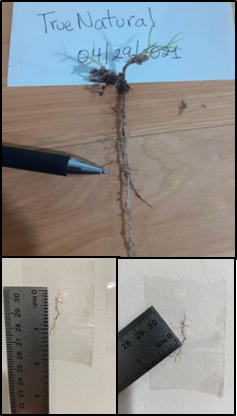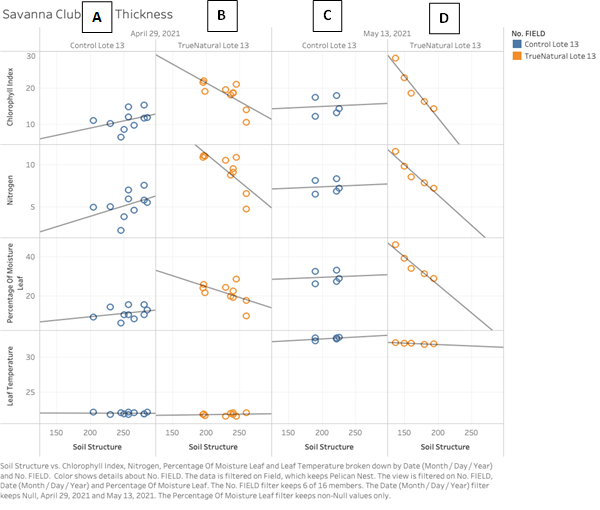Barrios, Jaime1; Alvarez, Darwin2; Gramajo, Javier3.
Resume:
This article “STRESS TOLERANCE IN TURFGRASS” discusses how biotic and abiotic factors can cause stress in plants, which affects their physiological functions and growth. Turfgrass is particularly vulnerable to stress caused by compacted soils, excess irrigation, pests, and diseases. The Trunatural Rizosfera program can improve the soil system and enhance the rhizosphere, which helps increase the plant’s natural defense system against stress. The program stimulates the growth and development of primary and secondary roots, leading to improved physiological efficiency and increased resistance to pests and diseases. Ultimately, improving the symbiosis of the soil-water-plant relationship is crucial for having unstressed plants with uniform growth and development.
STRESS: When plants get stressed, their physiological functions are affected by both biotic and abiotic factors. Also, growth and development functions are paralyzed, resulting in survival conditions. Processes such as photosynthesis, absorption of nutrients and minerals are stopped, and the growth of the roots consequently. According to studies carried out by the Department of Research and Development of TrueNatural, the most significant stress has been observed in the following conditions: compacted soils, excess irrigation, presence of pests, and diseases. Multiple tests have been performed and focused on minimizing and determining critical stress points under normal field conditions with recovery and maintenance applications of the Trunatural Rizosfera program.

IMPROVING THE SOIL SYSTEM: The improvement in the rhizosphere considerably increases the plants’ natural defense system to withstand the stress caused by any biotic or abiotic condition. Figure 1. Shows the quality of the rhizosphere in healthy and degraded soil conditions. When the rhizosphere is treated, the plant enters in normal growth and development conditions, allowing the roots to grow and develop uniformly.

FUNCTIONS OF THE ROOTS: More secondary roots per inch of the primary root are achieved when roots grow and develop uniformly. Figure two. Shows the number of secondary roots obtained from the rhizosphere in normal conditions of healthy soil. The growth of the primary roots and the appearance of secondary roots help mitigate the plants’ stress and improve the plants’ efficiency within 20 days. By improving the rhizosphere, the plants are given the ideal conditions to achieve physiological efficiency in chlorophyll index, nitrogen assimilation, and water content in the leaves; parameters. Figure three shows the correlations between the soil structure and the physiological parameters.
WHY DOES THIS HAPPEN? The stimulation of roots is mainly due to the improvement of aeration and soil biology. A living soil provides the necessary symbiosis for an excellent soil-water-plant relationship.
BENEFITS OF UNESTRESED PLANTS: The grass obtains its characteristic green color from the sanity of the foliar area because it has more resistance to attacks from pests and diseases and uniformly grows and develop during the entire cycle of life.
ADVANTAGES OF IMPROVING THE RHIZOSPHERE OF THE GRASS WITH THE TRUENATURAL PROGRAM

- Improves the soil structure.
- Provides life to the soil to improve the symbiosis of the soil-water-plant relationship.
- Improves the source-destination relationship (potentiates fertilization in all the points).
- Stimulates the growth and development of primary and secondary roots.
- The tolerance of lack of water is longer, and the plant’s physiology is not at risk.
Conclusions:
- Stress caused by biotic and abiotic factors affects the physiological functions of plants, leading to compromised growth and development.
- Turfgrass is particularly susceptible to stress caused by compacted soils, excess irrigation, pests, and diseases.
- The Trunatural Rizosfera program can improve the soil system and enhance the rhizosphere, which significantly increases the plants’ natural defense system against stress.
- The program stimulates the growth and development of primary and secondary roots, leading to improved physiological efficiency in chlorophyll index, nitrogen assimilation, and water content in the leaves.
- Improving the symbiosis of the soil-water-plant relationship is essential to having unstressed plants with increased resistance to pests and diseases and uniform growth and development.
- The Trunatural program’s advantages include improving soil structure, providing life to the soil, potentiating fertilization, and extending the tolerance of lack of water.
List of figures:
Figure 1. Rhizosphere in golf courses, A. Control rhizosphere, B. Rhizosphere using TrueNatural program Source: Barrios, J. 2021
Figure 2. Roots grow and development in Turf grass, A. Secondary roots grow, B. Number of secondary roots per inch, C. Length of secondary roots. Source: Barrios, J. 2021
Figure 3. Interaction of rhizosphere enhancement with physiological variables such as Leaf Temperature (F), Percentage of moinsture leaf (%), Nitrogen (mg.g-1), Chlorophyll index (SPAD). A and C: Control; B and D: TrueNatural Program. Source: Barrios, J & Alvarez, D. 2021.


